Top 5 Web Design Mistakes That Must Stop in 2020

Article by J.C. Yee
Graphics Design by Ryan Rivera
Now that we’re moving forward to another year again, it’s time to review some of the worst web design mistakes that compromised user experience, conversions, and sales because of businesses that don’t take their website seriously.
As 2020 marks the end of a decade, it’s vital to consider how things and people nowadays have extremely become digital. Brands must now take note of how their online presence will make an impact, in order to succeed in the years to come.
Here, we list down the top 5 web design mistakes that handicapped businesses’ online success because of negligence that came alongside the website development process. Some may be minor, but since the devil’s in the details, they can easily become the major reason why your website hasn’t been gaining attention.
1. Non-Mobile Responsive

We’ve said it before, and for 2020, we’ll say it again: websites should be optimized for mobile devices. With the growing trend of mobile users, it’s never been more serious for any company to have a website that works fine on phones and tablets.
Companies that don’t bother investing in a mobile-friendly website gives out the impression that setting it up was only done for the sake of having one. If your audience perceives this impression, then you’re putting your brand’s online presence at risk. People from your target market won’t visit, and in turn, would lower your company’s online conversion rate. In fact, research has already found out that even if they like a brand, 50% of users still won’t use its website if it isn’t mobile-friendly.
Mobile responsiveness affects your target market, your site’s search visibility, and your business as a whole. The bad user experience that will stem from unresponsive websites will inevitably pull your business down the search engine results pages. Once your brand finds itself in the uncharted pages of Google search, gaining its visibility back will cost more than twice the effort of setting up a mobile-friendly website.
Avoid the above-mentioned hassle when you start to adopt a responsive web design framework with a web design agency.
2. Poor Contents

Given that you’re already investing a fair amount of resources for awesome web design, it’s important to double-check and see if your site has engaging content (images, documents, media) that play a pivotal role in selling what you can offer as well as in elevating your online presence.
See, a lot of companies always overlook the importance of optimized content, which means that everything on your website should be adjusting for online viewing, especially with texts and images since these affect your site’s performance. If you’re just copying and pasting from a corporate PDF or PowerPoint presentation, then your website will suffer from slow loading speed, low search engine ranking, and subpar content which users won’t bother reading.
It gets worse when photos are taken straight from a camera partner such content since it’s compromising value over convenience. If this is the case with your company, then you essentially belittle the way your audience uses your website and perceives your brand.
With original, engaging content, you give your brand more depth and an opportunity to provide an easy way for users to associate themselves with it. Done right, visitors will be satisfied with browsing your website and will be more likely to recommend other people about it.
3. Non-Optimised Images

Another common mistake by plenty of businesses is when they upload photos on their website straight from a camera, without even lowering the resolution size. What they don’t know is that having non-optimized images negatively affects a website’s loading speed. This will ultimately result in a site that suffers from high bounce rates and low returns on investment.
In fact, since July 2018, Google has already been considering page speed as a factor for ranking websites in search engine results. With a slow page speed, websites that have non-optimized images will find it difficult to be visible on search engines, likewise making it harder for the business to generate leads, inquiries, and conversions online.
Verify your site’s speed with Google’s own web performance tool. Once you use this, you will be given insights that would make you take the necessary steps in improving your website.
4. Improper Use of Text Elements

Believe it or not, a lot of websites today are still plagued by the improper use of text elements such as spacing, line height, or overall typography. While it is commendable for a website to implement font combinations, succeeding in doing so requires a qualified understanding of how fonts work. Otherwise, the website will just suffer from a hard-to-read text that could cause site visitors to leave.
Like what we’ve said in our article about website branding techniques, the display of remarkable typography in every website will all come from the proper use of hierarchy, contrast, and space. To succeed in these aspects, you must first gain clarity on how your typography will best represent your brand’s tone. Once you’ve tackled these, you can now move forward with properly using factors such as:
- Kerning: This is the space between two letters. Ensure that each letter isn’t too close or too far from another.
- Tracking: The negative space inside a word or phrase. Expanding a word is sometimes done for aesthetics, but it still requires careful execution to stand out.
- Line height: The vertical spacing between lines of text. Having them too close or too far will both result in hard-to-read text, on top of looking awkward.
- Line length: The horizontal length of a text. There’s no one-size-fits-all when it comes to this. Just be mindful that if a text is already too long, consider cutting it to the next line.
When in doubt, consult a professional web designer who can help you achieve the best results.
5. Lack of Contact Information

Have you ever been frustrated by a company website that doesn’t show its address, email, or telephone number just when you are about to make an inquiry outside of it? If you ever get frustrated by this situation, then just imagine your site visitors experiencing the same. Part of ensuring that visitors get the ideal user experience is by providing them a holistic way of contacting you. If a visitor can’t reach you because of the lack of contact information on your website or because it’s hard to navigate to your contact page, then you just lost a potential sale.
One way of providing a seamless contact experience on your website is by having a smart contact integration wherein you have a button or icon that instantly connects them to you when clicked. This will save them a significant amount of time from having to manually type in your details, especially when they are browsing on mobile.
In terms of your location, we advise pinning your address on Google Maps so that a potential client can easily find your office. Done right, your website will make a significant contribution in generating conversions for your business.
Evaluate your website. Make it better with Gotafflair.
As we move forward to another year again, it’s time for companies to look back and review how they treat their websites as a key component in their success. After all, a website is not just the silent salesperson of your company, it is the cornerstone of a business’s online presence. This is the reason we encourage everyone to regularly update their website and keep it aligned with the latest trends and practices. If it provides a bad user experience, then it will instantly reflect what kind of brand you are.
Make the right call and start to improve your website today. Contact us at 798 8195 or email us at sales@gotafflair.com for a free, no-obligation consultation.


